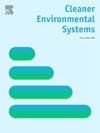A review of best international life cycle assessment (LCA) practices in wood construction: Challenges for Ireland
IF 4.9
Q2 ENGINEERING, ENVIRONMENTAL
引用次数: 0
Abstract
Under the dual pressure of carbon-neutral commitments by 2050 and increasing housing demands, the Irish construction industry is responsible for a 50% reduction in carbon emissions relative to 2018 levels. Timber has been identified as an excellent material choice for embodied carbon reduction. However, the widespread adoption of timber in construction is limited by several factors, including established practices and supply chains, and lack of public policy and incentives to quantify and reduce embodied carbon. The latter needs to be supported by accurate quantitative life cycle assessment (LCA). To identify gaps and challenges faced by LCA development for timber construction, this paper reviews various up-to-date Irish and international LCA practices. At the product level, 26 environmental product declaration (EPD) databases and 35 EPDs covering five wood product types are analysed. At the building level, 29 national and international building LCA methodologies worldwide are compared. Due to varying availability of Irish-customised data, disparities exist between the lifecycle inventory data used in current Irish timber product EPDs and other Irish-focused statistics. The challenges identified include a lack of mandatory regulations on embodied carbon disclosure and thresholds, a limited number of wood product EPDs in Ireland, and incomplete lifecycle inventory data.
木质建筑最佳国际生命周期评估(LCA)实践回顾:爱尔兰面临的挑战
在2050年碳中和承诺和不断增长的住房需求的双重压力下,爱尔兰建筑业的碳排放量相对于2018年的水平减少了50%。木材已被确定为一种极好的材料选择的隐含碳减少。然而,木材在建筑中的广泛采用受到几个因素的限制,包括既定的实践和供应链,以及缺乏量化和减少隐含碳的公共政策和激励措施。后者需要精确的定量生命周期评估(LCA)的支持。为了确定木材建筑LCA发展面临的差距和挑战,本文回顾了各种最新的爱尔兰和国际LCA实践。在产品层面,分析了26个环境产品声明(EPD)数据库和35个环境产品声明(EPD),涵盖5种木制品类型。在建筑层面,对全球29个国家和国际建筑LCA方法进行了比较。由于爱尔兰定制数据的可用性不同,目前爱尔兰木材产品epd中使用的生命周期库存数据与其他以爱尔兰为重点的统计数据之间存在差异。所确定的挑战包括缺乏对隐含碳披露和阈值的强制性法规,爱尔兰木制品epd数量有限,以及不完整的生命周期清单数据。
本文章由计算机程序翻译,如有差异,请以英文原文为准。
求助全文
约1分钟内获得全文
求助全文
来源期刊

Cleaner Environmental Systems
Environmental Science-Environmental Science (miscellaneous)
CiteScore
7.80
自引率
0.00%
发文量
32
审稿时长
52 days
 求助内容:
求助内容: 应助结果提醒方式:
应助结果提醒方式:


